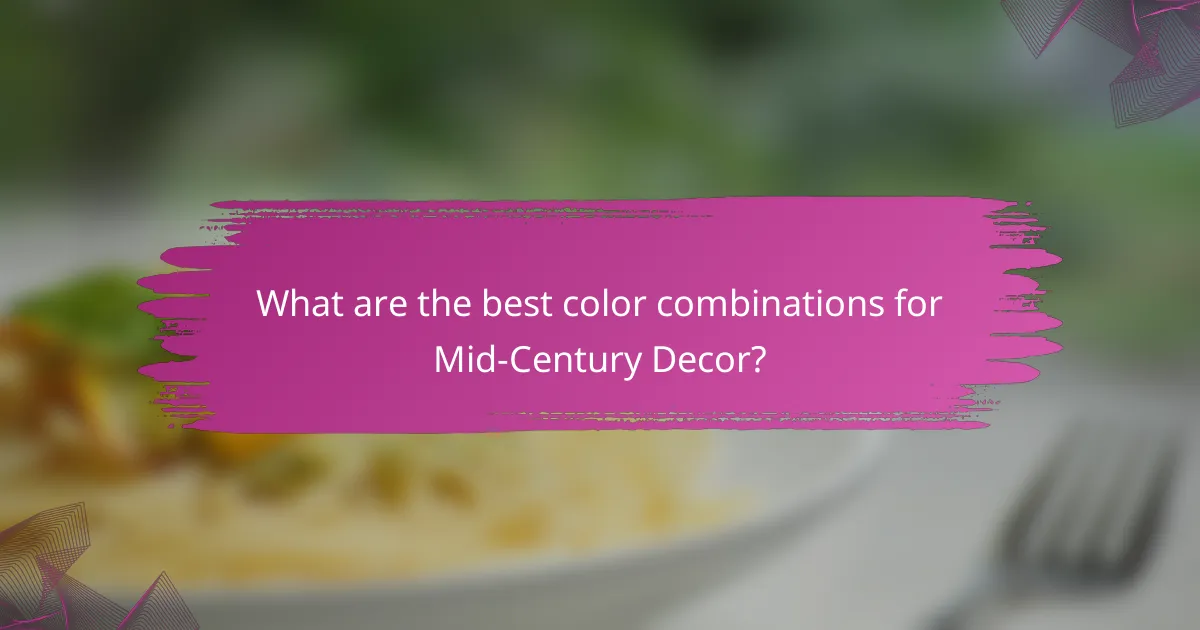Mid-Century decor is a celebration of retro aesthetics, characterized by organic shapes and bold colors that bring warmth and vibrancy to any space. This design style, flourishing from the 1940s to the 1960s, seamlessly blends functionality with artistic expression, creating environments that are both stylish and inviting. By incorporating iconic pieces and a mix of vintage and modern elements, you can transform your home into a timeless haven of creativity.

How to incorporate Mid-Century Decor in your home?
Incorporating Mid-Century decor into your home involves embracing organic shapes, bold colors, and a mix of vintage and modern elements. Focus on functional pieces that reflect iconic designs from the era to create a cohesive and stylish environment.
Use organic shapes in furniture
Organic shapes are a hallmark of Mid-Century decor, characterized by smooth lines and curves that evoke a natural feel. Look for furniture pieces like sofas, chairs, and tables that feature rounded edges and asymmetrical designs. These shapes not only enhance aesthetics but also promote comfort and flow in your space.
When selecting furniture, consider iconic pieces such as the Eames Lounge Chair or the Noguchi Coffee Table, which exemplify the organic forms of the era. Mixing these with more angular items can create a balanced look that still honors the Mid-Century style.
Choose bold color palettes
Bold color palettes are essential in Mid-Century decor, often featuring vibrant hues like mustard yellow, teal, and avocado green. These colors can be used on walls, furniture, or accent pieces to create a lively atmosphere. Pairing these bold colors with neutral tones can help to balance the overall look.
Consider using color blocking techniques, where you combine contrasting colors in a single room, to make a striking visual impact. Accessories like cushions, rugs, and artwork can also introduce pops of color without overwhelming the space.
Mix vintage and modern pieces
Mixing vintage and modern pieces is key to achieving an authentic Mid-Century look. Incorporate original vintage items from the 1950s and 1960s alongside contemporary designs that complement the aesthetic. This blend creates a dynamic and personalized environment.
When sourcing vintage items, check local thrift stores, flea markets, or online marketplaces for unique finds. Ensure that modern pieces harmonize in style and color with the vintage items to maintain a cohesive decor theme.
Focus on functional decor items
Mid-Century decor emphasizes functionality without sacrificing style. Choose decor items that serve a purpose, such as stylish storage solutions or multi-functional furniture. This approach not only keeps your space organized but also enhances its aesthetic appeal.
For example, consider a sleek sideboard that offers storage while showcasing decorative items. Look for pieces that combine beauty and practicality, ensuring that every item in your home contributes to both form and function.
Highlight iconic Mid-Century brands
Highlighting iconic Mid-Century brands can elevate your decor and provide a sense of authenticity. Brands like Herman Miller, Knoll, and Plycraft are renowned for their contributions to Mid-Century design. Incorporating pieces from these brands can serve as focal points in your home.
Research and invest in well-known designs that resonate with your style. Authentic pieces may come at a premium, but they often appreciate in value and add character to your space. Look for replicas if budget constraints are a concern, ensuring they maintain the essence of the original designs.

What are the key characteristics of Mid-Century Decor?
Mid-Century Decor is defined by its emphasis on organic shapes, bold colors, and minimalist design principles. This style, popular from the 1940s to the 1960s, combines functionality with aesthetic appeal, creating spaces that feel both modern and inviting.
Organic shapes and curves
Organic shapes and curves are central to Mid-Century Decor, often seen in furniture and architectural elements. These forms mimic natural silhouettes, promoting a sense of flow and comfort in a space.
When selecting furniture, look for pieces with rounded edges, asymmetrical designs, and fluid lines. For instance, a sofa with a curved back or a coffee table with a soft, organic shape can enhance the overall aesthetic.
Bold and vibrant colors
Bold and vibrant colors are hallmark features of Mid-Century Decor, often used to create striking contrasts and energize spaces. Common color palettes include rich hues like mustard yellow, teal, and avocado green, often paired with neutral tones.
To incorporate these colors effectively, consider using them as accent walls, in upholstery, or through decorative accessories. A bright orange chair or a deep blue rug can serve as focal points in a room.
Minimalist design principles
Minimalist design principles are fundamental to Mid-Century Decor, emphasizing simplicity and functionality. This approach avoids clutter, focusing instead on essential forms and clean lines.
To achieve a minimalist look, choose furniture that serves multiple purposes and keep decor items to a minimum. Opt for a few statement pieces rather than overcrowding a space with numerous items.
Integration of natural materials
Integration of natural materials is a key aspect of Mid-Century Decor, promoting sustainability and warmth. Common materials include wood, leather, and stone, which add texture and authenticity to interiors.
When furnishing your space, prioritize items made from high-quality, natural materials. A walnut dining table or a leather armchair not only enhances the aesthetic but also contributes to a more inviting atmosphere.

Where to find Mid-Century Decor items in Canada?
In Canada, you can discover Mid-Century decor items through various local vintage shops, online retailers, and antique markets. Each option offers unique selections that reflect the retro aesthetics, organic shapes, and bold colors characteristic of this design style.
Local vintage shops in Toronto
Toronto boasts a vibrant selection of local vintage shops that specialize in Mid-Century decor. Stores like Queen Street West and Parkdale feature a variety of furniture, lighting, and accessories from the 1950s to 1970s. Expect to find unique pieces that add character to your home.
When visiting these shops, consider checking for items that are in good condition but may require minor restoration. This can often lead to better deals and one-of-a-kind finds.
Online retailers like Wayfair
Online retailers such as Wayfair offer a convenient way to shop for Mid-Century decor from the comfort of your home. They provide a wide range of options, including furniture, decor items, and lighting, often categorized under ‘Mid-Century Modern’ for easy browsing.
Look for sales and discounts, as many online stores frequently offer promotions. Reading customer reviews can also help ensure the quality of your purchases.
Antique markets in Vancouver
Vancouver’s antique markets are treasure troves for Mid-Century decor enthusiasts. Markets like Antique Row on Main Street and the Vancouver Flea Market feature numerous vendors selling authentic vintage items. You can find everything from furniture to decorative art pieces.
Be prepared to negotiate prices, as many vendors are open to offers. Arriving early can give you the best selection of items before they sell out.
Specialty stores in Montreal
Montreal is home to several specialty stores that focus on Mid-Century decor. Shops such as Les Étoffes and La Maison d’Antique curate collections that reflect the era’s distinctive style, offering both furniture and decorative objects.
When shopping in these stores, consider the overall aesthetic of your space and how each piece will fit. Don’t hesitate to ask store owners for their recommendations on popular items or emerging trends in Mid-Century design.

How to style a Mid-Century living room?
To style a Mid-Century living room, focus on creating a space that emphasizes retro aesthetics through organic shapes, bold colors, and functional design. Prioritize furniture arrangements that encourage conversation and incorporate unique lighting and area rugs to enhance the overall ambiance.
Arrange furniture for conversation
Arranging furniture for conversation is essential in a Mid-Century living room. Position sofas and chairs to face each other, creating an inviting atmosphere that encourages interaction. Aim for a circular or semi-circular layout to foster a sense of community.
Consider using low-profile furniture that reflects the era’s design principles. Pieces with tapered legs and soft curves not only enhance the aesthetic but also maintain an open feel in the space. Avoid overcrowding; leave enough room for movement and flow.
Incorporate statement lighting fixtures
Statement lighting fixtures are a hallmark of Mid-Century decor. Look for unique designs such as starburst chandeliers or sculptural floor lamps that serve as focal points in the room. These pieces should complement the overall color scheme while adding visual interest.
Choose fixtures with materials like brass or wood, which were popular during the Mid-Century period. Ensure that the lighting is functional; consider layering different types of lighting, such as ambient, task, and accent, to create a warm and inviting atmosphere.
Use area rugs to define spaces
Area rugs play a crucial role in defining spaces within a Mid-Century living room. Select rugs with bold patterns or colors that reflect the era’s aesthetic, such as geometric designs or vibrant hues. These rugs can help delineate seating areas and add warmth to the room.
When placing rugs, ensure they are large enough to accommodate all furniture pieces within a seating area. Ideally, the front legs of sofas and chairs should rest on the rug, creating a cohesive look. This not only enhances the design but also adds comfort underfoot.

What are the best color combinations for Mid-Century Decor?
The best color combinations for Mid-Century Decor often feature bold, contrasting hues that evoke a sense of warmth and vibrancy. Key pairings include teal with mustard yellow, olive green with burnt orange, and charcoal gray with white, each offering a unique aesthetic that embodies the retro charm of this design style.
Teal and mustard yellow
Teal and mustard yellow create a striking visual contrast that is both lively and inviting. This combination works well in living spaces, where teal can be used for larger furniture pieces like sofas or accent walls, while mustard yellow can be introduced through smaller elements such as cushions or artwork.
When using this pairing, consider the balance of colors; too much mustard yellow can overwhelm a space, while too little may not provide the desired pop. Aim for a ratio that keeps teal as the dominant color, with mustard yellow as a vibrant accent.
Olive green and burnt orange
Olive green and burnt orange evoke a natural, earthy feel, reminiscent of autumn landscapes. This combination is particularly effective in kitchens or dining areas, where the warm tones can create a cozy atmosphere.
To implement this pairing, use olive green for cabinetry or larger furniture items, and incorporate burnt orange through decorative accents like tableware or wall art. Be mindful of the saturation levels; muted tones can create a sophisticated look, while brighter shades can energize the space.
Charcoal gray and white
Charcoal gray and white offer a timeless and elegant contrast that suits various Mid-Century spaces. This combination is ideal for creating a clean, modern aesthetic, often seen in minimalist designs.
Utilize charcoal gray for larger elements such as walls or furniture, while white can be used for trim, ceilings, or accessories. This pairing allows for flexibility, as it can be easily accented with pops of color from other palettes, maintaining the retro vibe without overwhelming the space.
